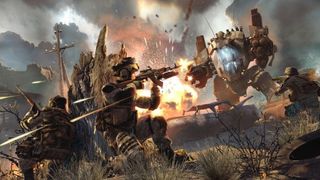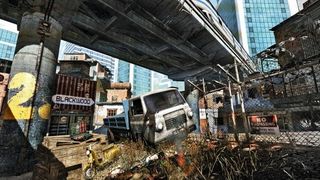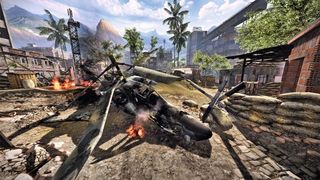Warface hands-on: the silliest name in games conceals a F2P shooter of serious ambition

There's nothing necessarily wrong with that, of course, but I found that both encounters lasted just a little bit too long. When you're running headlong through the streets with your finger on the trigger, the game's simplistic AI isn't an issue – these aren't real combatants, they're satisfying kills waiting to happen.
When you're locked into a single location circling a single foe, however, the curtain seems to fall away and you have time to wonder at the absurdity of what you're actually doing. There's every chance that more competent teams will be able to clear these sections faster, of course, but it'd be good to see the pacing tweaked for the game's Western release.
Co-op mode is delivered to the player as a series of daily challenges. A selection of maps will cycle in and out as time goes on, with a full range of difficulty levels and time-limited rewards to match. “Once they've played the maps with their friends they move over to PvP, and then come back the next day,” Holzapfel explains. “This takes away many things that could confuse or frustrate the player.” It's also, Crytek are keen to stress, a way into multiplayer shooters that is less intimidating than going up against human opponents.

The influence of the arcade is apparent in other ways. In Russia, players are able to buy instant respawn coins that allow them to revive in the field in co-op mode rather than wait for the next checkpoint. Crytek see this as the equivalent of pumping more tokens into an arcade cabinet – while the very best players will be able to clear stages on a single credit, microtransactions are there for everyone else.
"In Russia, players are able to buy instant respawn coins."
The structure of the store in the European and North American version of the game is yet to be confirmed, as are prices. Respawn coins seem likely to make the transition, as they support the basic mechanics of co-op mode.
In general, though, expect to have to shell out for experience boosters, skins, and equipment for your character.
Weapons and weapon attachments are an obvious example, but the clothes you're wearing also alter the game's mechanics – a particular set of boots might slow the detonation time on enemy mines, for example, while a pair of climbing gloves will allow you to traverse co-op mantling points by yourself if you haven't got any friends.
The biggest gaming news, reviews and hardware deals
Keep up to date with the most important stories and the best deals, as picked by the PC Gamer team.

The comparison to make here is Team Fortress 2, and the way that item builds have added variety to the way individual classes approach the game. The onus is on Crytek to ensure that these paid-for – and earned – advantages don't undermine the rest of what the game
is trying to achieve.
“With the free model, it's really just about delivering a good experience,” Holzapfel says. “Otherwise people will just leave, because they didn't invest anything in it.” The thing that impresses me most about Warface is Crytek's understanding of the kind of game they're making, and where it fits into players' lives.
The last few years have seen the systematic breakdown of the old methods of making and selling games, with the only real exception being the most mainstream experiences – sports games and shooters, specifically. By making the shooter more accessible and cheaper while remaining fully featured, Crytek have a chance to challenge the amount of money people feel they need to spend to get their lunchtime deathmatch fix.
One way of responding to a name like Warface, then, is relief. It shows that, at long last, the shooter is figuring out exactly what it's for.
Joining in 2011, Chris made his start with PC Gamer turning beautiful trees into magazines, first as a writer and later as deputy editor. Once PCG's reluctant MMO champion , his discovery of Dota 2 in 2012 led him to much darker, stranger places. In 2015, Chris became the editor of PC Gamer Pro, overseeing our online coverage of competitive gaming and esports. He left in 2017, and can be now found making games and recording the Crate & Crowbar podcast.
Most Popular


